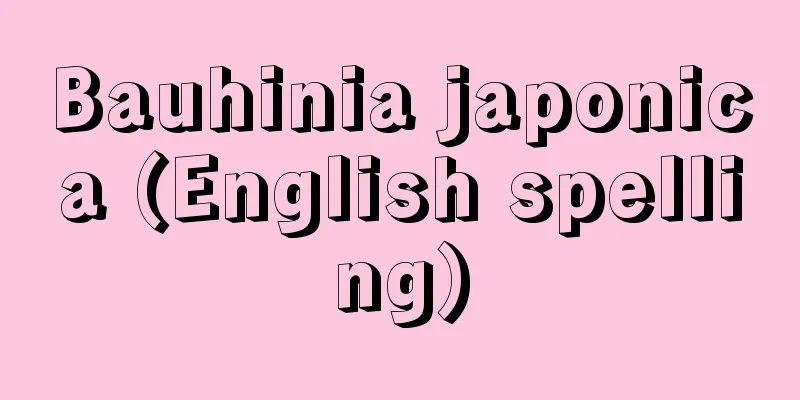Hakozaki Shrine

|
Located in Hakozaki-cho, Higashi-ku, Fukuoka City. The deities worshipped are Emperor Ojin, Empress Jingu, and Tamayorihime-no-mikoto. Formerly a government-sponsored grand shrine. It is listed as "Hachiman Daibosatsu Hakozaki-gu" in the Shinmeicho (list of deities) of the Engishiki, and is listed as a Myojin-taisha (myōjin-taisha). The pine forest "Chiyo-no-matsubara" along the coast of Hakata Bay near the shrine grounds has long been said to be the sacred tree of the main shrine, and it is said that the place name and shrine name were given based on the legend that when Emperor Ojin was born, his placenta was placed in a box and buried in this ground, and the "sign pine" was planted. In 759 (Tenpyō-hōji 3), the shrine building was constructed under the "sign pine" after receiving a divine oracle from Hachiman. According to another legend of the shrine, the shrine was established in 921 (Engi 21) after Usa Hachimangu Shrine was invited to the area. After the Heian period, as Hachiman faith developed, the shrine became a famous large shrine in Kyushu, and especially during the national crisis of the Kamakura period when the Mongol invasion occurred, the shrine attracted the reverence of both the court and the public as a god of the surrender of enemy countries. The main shrine building was burned down during the invasion, so in 1275 (Kenji 1), the main shrine building was rebuilt and a formal shrine transfer ceremony was held, with the retired Emperor Kameyama writing the four characters "enemy country surrender" in gold paint on dark blue paper and donating it. It is still preserved as a sacred treasure today. To protect against the Western Sea, the main shrine building faces west, facing Hakata Bay and the Genkai Sea. The main hall and worship hall were rebuilt in 1546 (Tenbun 15), and the tower gate in 1594 (Bunroku 3), and they are designated as important cultural properties of Japan. The annual festival is held from September 12th to 18th (with a Shinko Festival every other year). The Tamaseseri Festival on January 3rd is famous. [Soji Okada] Fukuoka City, Fukuoka Prefecture ©Fukuoka City "> Hakozaki Shrine Hakozaki Shrine, Fukuoka City, Fukuoka Prefecture ©Fukuoka City "> Tamaseseri Festival Source: Shogakukan Encyclopedia Nipponica About Encyclopedia Nipponica Information | Legend |
|
福岡市東区箱崎町に鎮座。祭神は応神(おうじん)天皇、神功(じんぐう)皇后、玉依姫命(たまよりひめのみこと)を祀(まつ)る。旧官幣大社。『延喜式(えんぎしき)』神名帳(しんめいちょう)に「八幡大菩薩(はちまんだいぼさつ)筥崎宮」とあり、名神(みょうじん)大社に列す。境内近くの博多(はかた)湾沿岸一帯にある松林「千代ノ松原」は、古くより本社の神木と伝えられており、応神天皇誕生のとき胞衣(えな)を箱に入れてこの地に埋め「しるしの松」を植えたという伝説に基づいて地名・社名がつけられたと伝える。759年(天平宝字3)八幡神の神託を受け「しるしの松」の下に社殿が造営されたという。また別の同宮縁起(えんぎ)によると、921年(延喜21)宇佐(うさ)八幡宮を勧請(かんじょう)し鎮座したと伝える。平安期以降は八幡信仰の発展に伴って、九州の著名な大社となり、とくに鎌倉時代蒙古(もうこ)襲来の国難に際しては、敵国降伏(ごうぶく)の神として朝野の尊崇を集めた。この外寇(がいこう)によって社殿を焼失したため1275年(建治1)社殿を再建して正遷宮を行い、亀山(かめやま)上皇は「敵国降伏」の四字を紺紙(こんし)に金泥(きんでい)で謹書して奉納した。現在も神宝として伝存している。西海(さいかい)防護のため社殿は西方を向き、博多湾に臨み玄界灘(げんかいなだ)に面している。本殿・拝殿は1546年(天文15)、楼門は1594年(文禄3)の再建で、国の重要文化財に指定されている。例祭は9月12~18日(隔年に神幸祭あり)。正月3日の玉取祭(玉せせり)は有名。 [岡田荘司] 福岡県福岡市©福岡市"> 筥崎宮 福岡県福岡市 筥崎宮©福岡市"> 玉取祭(玉せせり) 出典 小学館 日本大百科全書(ニッポニカ)日本大百科全書(ニッポニカ)について 情報 | 凡例 |
Recommend
forearm
...The hand is from the wrist down. [Arm] Because...
Tokuyama Bay
An inlet located almost in the center of the Seto...
Hemp seeds - Asanomi
Hemp, native to Central and Western Asia, blooms ...
Furyu - Elegant
〘noun〙① The style left by one's ancestors. Tra...
Yuan Yuan (English spelling)
In ancient China, a natural garden was a vast area...
Qutlugh Boyla (English spelling) Qutlugh Boyla
…However, the Tenguri Khan, who took the throne o...
Gymnura japonica (English spelling) Gymnura japonica
…[Toru Taniuchi]. … *Some of the terminology that...
Odamaki Hills
...Three terraces have developed along the Arakaw...
Even if it rains
…Since 1957, he has produced many hit songs, and ...
Okinawa Koto Music
...During the Goryeo period, the koto was used on...
Space lattice - Kuukankoushi (English spelling) space lattice
When three fundamental vectors a , b , and c are ...
Amio, JJM - Amio
…But the background to this was the existence of ...
Picture and text belt circular milk god beast mirror - Gamon Taikanjo Nyuushinjukyo
...The main image in the inner section is a monst...
Peroxomonosulfuric acid
...Persulfuric acid is a misnomer. (1) Peroxomono...
Ito Sukenori
1589-1636 A daimyo in the early Edo period. Born ...









